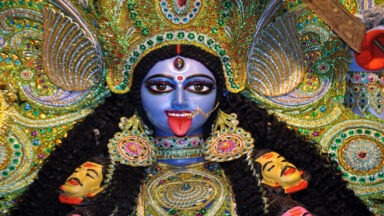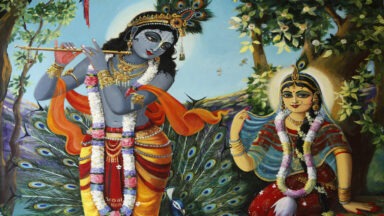Aparigraha: The Forgotten Yama

Of all the yogic teachings, the most well known to newcomers and experienced yogis alike is asana (the postures) because we all physically practice them in yoga class. Students of yoga philosophy are also familiar with the first two limbs of yoga—the yamas and niyamas—described by the sage Patanjali in the Yoga Sutras.
The yamas are the universal codes of ethical behavior and niyamas are the personal observances—essentially guidance for how enlightened beings can best interact with the world, our friends, our families, and our selves. These ten practices and their translations can become intuitive and awakened within us when we place our attention on them, live them, and practice them.
Of the five yamas—ahimsa (non-violence), satya (not lying), asteya (not stealing), brahmacharya (sexual impeccability), and aparigraha (not coveting)—it is often the fifth yama, aparigraha, that seems to get lost in the shuffle. Maybe because it’s last on the list or seems difficult to pronounce (a-par-i-gra-ha), or perhaps it appears the same as asteya, which is more about taking what isn’t ours. In contrast, aparigraha is about greed-based desire that is rooted in jealousy: to inhabit what someone else is, where they are in life, or what they have.
Aparigraha is looking at someone else and saying “I want that,” whether or not we have the same ability, experience, physiology, knowledge or desires as that other person. An easy example is when we are admiring/coveting someone else’s asana in yoga class. I recently taught a class where all my students wore blindfolds to awaken their aparigraha!! Pretty trippy.
As we move throughout the day, we often judge the world around us; we compare ourselves to other people, their successes, their ah-ha moments, and their celebrations. We ooh and aah over someone else’s bag, shoes, car, boyfriend, girlfriend, spouse, status, success, money, or happiness. And then we feel less than. There are eight billion people on planet Earth and if we try to compare ourselves to eight billion other people, it’s like comparing bananas to oranges to grapes to cotton balls to geodes to leaves to birds – how can you compare those? You can’t. Just like those you might covet, there may be those who covet you and what you have. The cycle of jealousy is infinite unless you choose to step into your grace and step beyond it.
When you start to feel that jealousy bubbling up, remind yourself “aparigraha, aparigraha”, then shift to gratitude. Stop for a moment and recognize something you do have that is amazing or something that could use some work. Celebrate the other person and what they have…and when you can merge with their excitement, that’s yoga, that’s union, that’s one-ness.
Practicing aparigraha helps us better discover the brilliance and divinity within our own selves so that we would never look at someone else and do anything other than root for them. Others we might “covet” demonstrate that the world is infinite and that what we can attract for ourselves is boundless. There’s enough room for all of us to play in the ever-expanding sandbox of the universe. No one really gets in our way; in fact, others’ successes can instill confidence within us that we too can succeed. No one is truly competing with us; others’ triumphs can point the way to the magnificence that is available to all of us.
When you rely on your own abundance and creativity, you can bloom and blossom and flourish without comparing yourself to anyone else. Even if you work side-by-side with someone and you both have the same exact title and compensation, what’s to compare? You’re on your path; they’re on theirs.
Practicing aparigraha is more than not coveting others. It’s celebrating what is ours and reminding us to reach for the stars rather than gazing at someone else’s. In that process, there is no coveting; there is no jealousy—only the excitement of the miracles in our life yet to unfold.
What is Ahimsa and How to Practice It in Everyday Life

Whether you’re experienced in yoga or just starting out, integrating the practice of ahimsa in everyday life can lead to wonderful strides. Ahimsa is one of the five yamas, which are the ethical, moral and societal guidelines for yogis. Ahimsa can be distilled into a practice of non-violence in all aspects of life, from the physical to the mental and emotional.
Non-violence is defined by honest compassion and true love. You can achieve this by embracing love: learn to love deeply, and also to be loved. However, this is impossible to do if you choose to ignore or escape from certain traits held in yourself.
How Does Non-Violence Manifest in Daily Life?
To understand how non-violence can manifest in our lives each day, we must first learn how subtle daily actions and responses contain elements of violence. This often happens against ourselves. When our thoughts contain negative responses like disappointment, resentment, or guilt, when we feel shame, we are subtly creating violence. If you can’t forgive someone for something they’ve done against you, or if you can’t forgive yourself for something you’ve done, this is an act of violence because it pushes love away.
Expecting too much of yourself and putting all responsibility in your own hands is a type of violence too, as is expecting that the world will run according to your design. You’re being violent towards yourself and the world at large with these kinds of mindsets. Acting out of our fears is a form of violence to the self. We inflict violence on others daily in subtle ways, but this is simply an outward expression of the war that goes on inside of everyone. For instance, when we resent others, it creates a negative atmosphere. Finding inner peace through ahimsa will in turn allow us to come to peace in interactions with others. This may come as a surprise if you consider yourself a non-violent person. Consider how violence can function in the subtlest of ways. Violence disguises itself well; it manifests in words, actions and even inner thoughts.
Instead, embrace and act from your inner truth. Truth and non-violence are a pair.
Yoga is a great way to access ahimsa in our daily interactions. By practicing yoga daily, you can confront your own inner darkness impartially and with compassion. This then paves the way for transforming negative emotions and tendencies without acting on these feelings.
Yoga creates the avenue to getting in touch with any violence you hold inside of you through non-violent means and therefore to express negativity without hurting anyone, yourself included. Releasing negative energy through positive intentions transcends the negative aspects of yourself, creating peace in the world around you.
How to Incorporate Ahimsa
You can incorporate ahimsa into daily activities. For example, some yogis don’t eat meat. But whatever you decide to do with your diet, you should focus on practicing self love in all that you do.
Another way to bring ahimsa into your life is through compassion. It’s the ability to accept events as they are with an open heart, letting go of reacting in any negative way and replacing those feelings with kindness and acceptance.
Also, move with intention. Consciously put non-violence into action. Instead of letting the limits of your body create stress, make the decision to intentionally respect and even love the limitations your own body has. Perform yoga poses gracefully, but do it without force.
Yoga gives you the chance to practice non-violence in your mind at the same time. While tuning in to your body, simultaneously start to watch as your thoughts form. Cultivate your awareness of your own thoughts to find if there are hints of violence against yourself or others in your life. Awareness doesn’t mean reaction, though. You don’t need to push these thoughts away ” just recognize them. Observe as they come into your consciousness, and then watch as they again leave.
Ahimsa in the Body and Mind
We can understand ahimsa as the being mindful of thoughts. Thoughts naturally move into and out of our minds. The thoughts themselves don’t necessarily cause harm. However, holding onto thoughts and letting them repeat again and again in your mind is what in the end turns into actions or words of violence. Start to practice simply observing your thoughts instead of reacting to them. When you allow yourself to acknowledge and observe, you’ll find that your thoughts slip from your awareness just as easily as they come in.
You can be at the peak of health and still have your thoughts deeply affect your wellbeing. Yes, exercising and eating well are hugely important for your health, but even if you do these things “right,” your thoughts can harm you. Negative thinking sends out messages to the body that trigger the fight or flight response. Thoughts do this even if there’s no outside threat.
The fight or flight response secretes cortisol, which you might know better as the stress hormone. This, in turn, lowers the immune system, and that then makes us more likely to experience physical pain and sickness. And again, it’s not just those pesky bad thoughts we have about ourselves that do this. Jealousy, anger and judgement toward others make us feel bad as well.
That’s where our non-violent thoughts come in. When we think lovingly, these thoughts trigger dopamine’s release into the body. Dopamine is that chemical that makes you feel good and relax. Unlike cortisol, dopamine brings strength to the immune system. It can even cure illness. Those who think of themselves as optimists tend to have stronger immune systems and recover faster from illnesses and injuries. Optimists may even live longer than those who think of themselves as pessimists.
What This Means for You
When you turn your yoga practice into a complete lifestyle, ahimsa can guide your daily interactions with yourself and others. Anyone, regardless of experience, can get frustrated when the physical components of yoga don’t move forward as quickly as planned. Keeping ahimsa in mind as we practice yoga lets us move out of negative thoughts about the body. We can then accept ourselves totally, no matter how flexible, how strong we may be in any given moment.
This translates to all aspects of our lives. In the physical sense, non-violence means not pushing yourself over the edge. You can, of course, still challenge yourself so that you can grow; in fact, you must. But embracing ahimsa means not pushing yourself to harm.
You shouldn’t put much stock in holding a handstand long enough to please your ego if it brings you harm. Likewise, you shouldn’t hold on to resentment or jealousy against yourself or someone else. Embracing ahimsa instead will improve your own well-being as well as those around you.
Everyone holds pain inside themselves, but you can overcome this in a positive way when you practice ahimsa. There is nothing inherently wrong with this; it’s human nature. We must, however, learn to fully experience these negative feeling without reacting negatively to them. This may seem contradictory, but ahimsa leads to a path of peaceful living. By observing but not acting on our natural feelings of pain, hatred, pain and violence will move out of our lives, and doors will open to new understanding.
Let go of expectations of what you should do. Stop clinging to the need to scold yourself with negative, violent thoughts. When we do this, our bodies respond. Instead of bringing in those negative emotions and working against us, our bodies start working with us.
Practice ahimsa in your interactions each day by accepting, then releasing negative thoughts about yourself and others. If you’re looking for other ways to bring ahimsa into your everyday practices, you can find them here on Gaia. You can have ahimsa in your diet, in your thoughts, and in how you communicate with the people around you.
The yoga practice of non-violence can easily move into all aspects of your life. Yoga creates a peaceful reconciliation with your true nature. Non-violence comes from love of the true self, from true self-acceptance. This ahimsa comes from deep in the heart.





































